Tiger Leaping Gorge is the Grand Canyon of China. After taking its famous hairpin turn, the Yangtze River plunges into a narrow and deep gorge, which got its name from a supposedly intrepid tiger who leapt across to escape pursuing hunters. Since China's tourism industry is famous for its overly generous descriptions of natural wonders, we weren't sure what to expect from the pre-visit hype about the gorge's beauty and grandeur.
Like all Chinese attractions, the gorge had a sign at the entrance littered with amusing Chinglish. We paused to read it, and you should too:
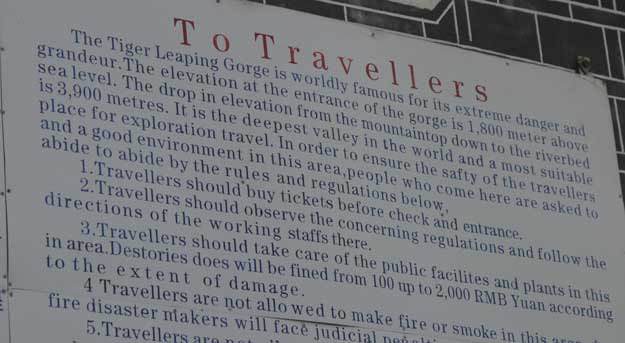
Despite the warnings, it didn't look all that dangerous, so we sauntered along the path, pausing for a photo at the entrance rock:
 |
As you can see, the sun was blazing. We felt like a walking ad for our ultra-practical hats, which again proved their worth, as they have in many countries, keeping the sun at bay. So many people comment on the hats (from Sunday Afternoons in Oregon) that we now refer to them as our "tribal headgear"! |
The juxtaposition of cautionary signage and stunning scenery continued as we ambled along a path that had been literally carved into the face of the marble-veined cliff. The path was paved with the same marble, creating an overall impression of extraordinary grandeur (just like the sign said!)
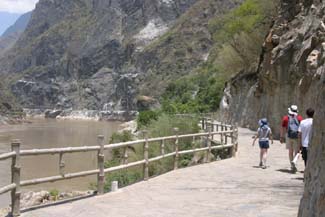 |
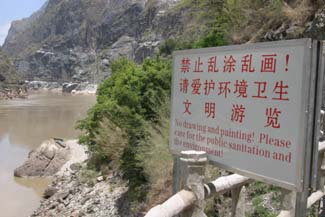 |
Perhaps because of the signs that kept warning people to not carve their names in the rock, we saw no graffiti, anywhere. A truly amazing accomplishment.
We then rounded a corner, and began to understand what the "extreme danger" was all about:
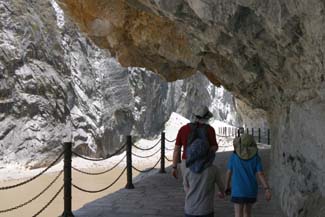 |
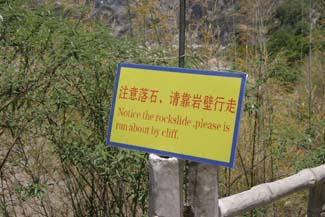 |
We were now walking underneath a cliff that had been recently carved out of living rock! As the signs made quite clear, there was a serious risk of falling rocks. To ensure that everyone paid attention to the warnings, every 200 meters or so stood a young army private, armed with a megaphone and flags. If you strayed too far to the left (in other words, into prime rockfall area), they were quick to yell and wave flags, urging you to hug the cliff.
Their job was made much easier by the ample evidence of massive -and fresh - rock slides all around us:
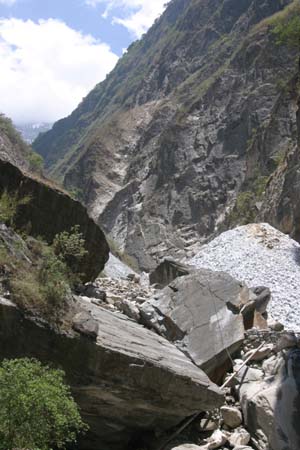 |
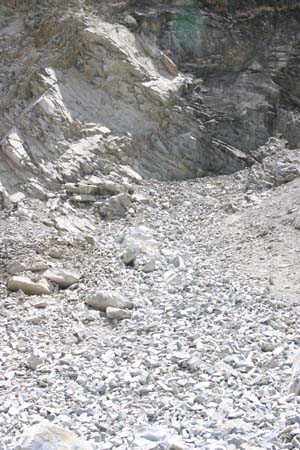 |
It was clear that we were walking through an area that was not only geologically active, but also not entirely happy about the huge man-made gashes made through previously-solid rock. Fortunately for our peace of mind, Huang waited to tell us about various tourists he had heard about being crushed by falling rocks until AFTER we were safely back in our van. Thanks, Huang!
Just when we were getting tired of being reminded of potential rockslides, the path turned and entered a long, dark tunnel. Its cool interior was a welcome, if brief, relief to the blazing sun.
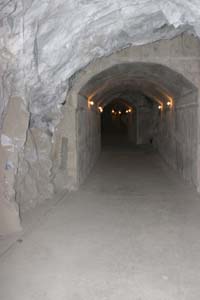 |
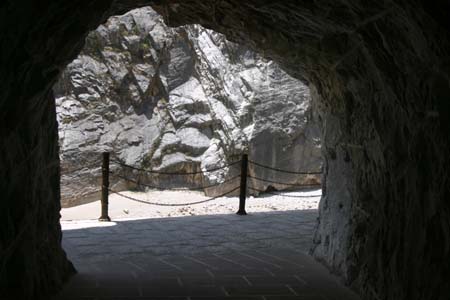 |
Just as our eyes had become adjusted to the darkness of the tunnel, it suddenly ended, facing a solid wall of rock, accompanied by a roaring sound. We left the tunnel to find ferocious rapids -- the placid river had turned torrential, just in the short time we had spent in the tunnel:
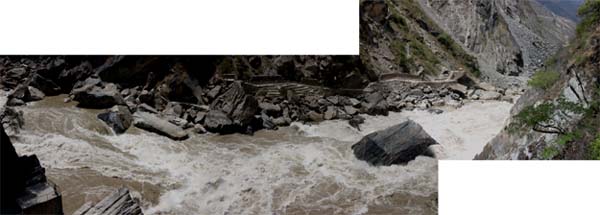
Huang, who has hiked and trekked the gorge for years before this path was carved, explained that a few months ago the river had been much higher -- so high that the big rock in the middle was completely covered with water. We could only imagine what it would be like to be shooting these rapids, feeling pretty good, before smashing up against the hidden boulder...
As you can see in the picture above, there is also a path on the other side of the gorge. It looked a bit dangerous, until we realized that it was just like the one we were on! Our path curved as well, and after several more meters we came upon the sight we had come to see -- the leaping tiger -- here memorialized by a huge statue on the right side of the photo:
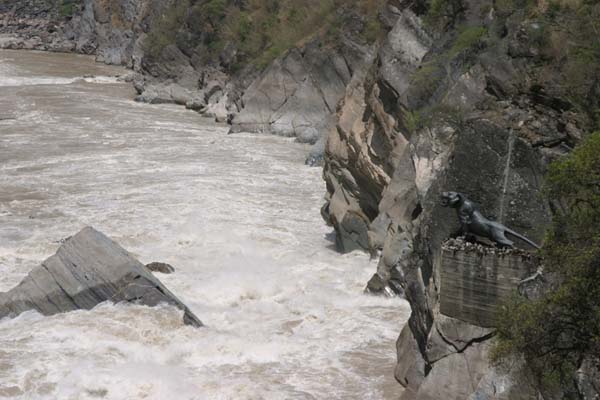
It's hard to say if any tiger could have really made that leap, especially when it became clear that it would have had to leap not just once, but twice, in quick succession!

It's worth taking a close look at the photo above to get a sense of scale. On the right is the same tiger statue, which stands about 10 feet tall. On the left, about halfway down, is a flat, light-colored viewing area. If you squint you can see tourists standing there oogling the river. In other words, the gorge is HUGE!
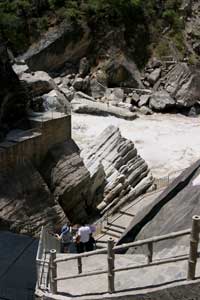 |
The path ended at this point. But a further adventure beckoned -- the brave could walk down a long stairway, right to the water's edge. Sami and I, seasoned from our white-water rafting trip in Oregon, decided to take the plunge (figuratively speaking).
|
Sami scampered down the steps while I took them a bit more carefully. Several times she disappeared around a corner -- I held my breath in hopes that she didn't slip and fall, to be instantly swept away. When we both finally reached the lowest level, the sight was truly awesome:
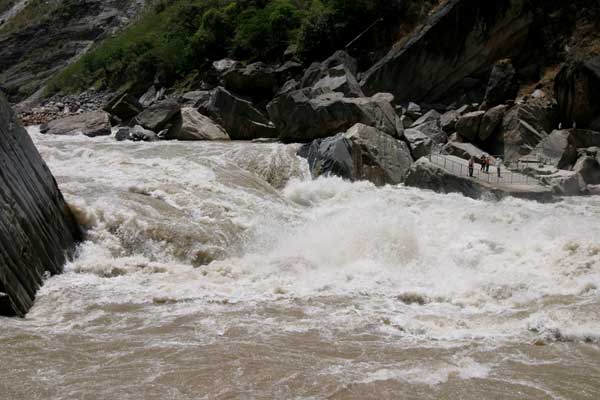
It's impossible to describe the sensation of standing just meters away from an onslaught of rushing water. If river rapids had a tsunami equivalent this was it! Note the people standing in the veiwing area across the river -- that's how close we were to the rapids! It was a little creepy to know that the platform on which we were standing would easily become submerged if the river rose just a fraction.
Sharon and Miranda had stayed up on the path, so after ogling the rapids, we looked up to wave at them. If you look carefully, you can see them waving from the bridge, at the extreme right side of the photo below:
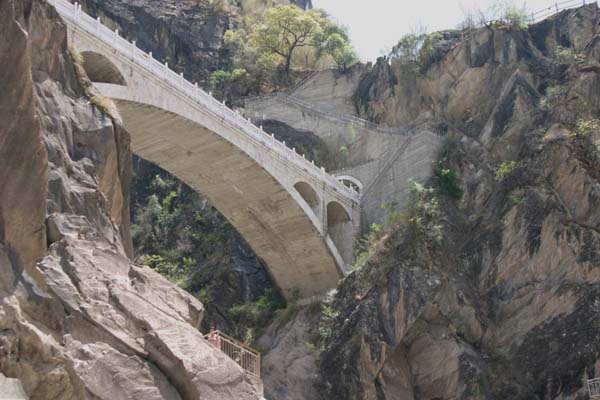
It was a long climb back up to see them, especially given the high altitude, so we decided to get going. But first, Huang snapped a quick photo of us, backed by the Yangtze, China's greatest river, in all its roaring glory:

Bottom line -- go to Leaping Tiger Gorge before the Chinese government decides its time to harness the rapids into an amazing source of hydroelectric power!
Next: Zhongdian